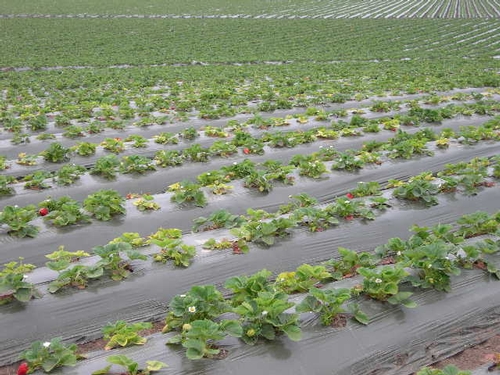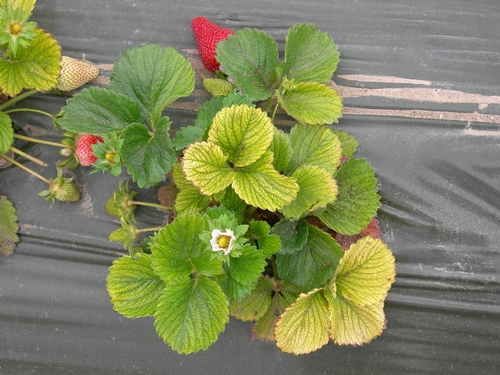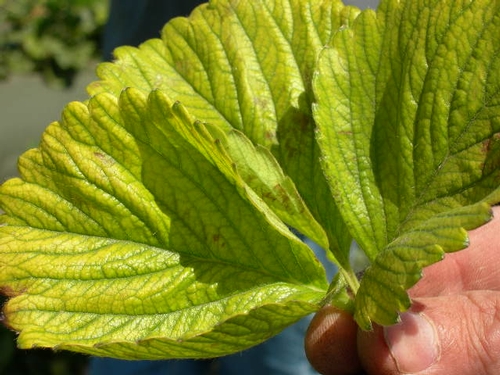One of the less well understood issues in our industry on the Central Coast is the phenomenon of yellowing of strawberry plants in certain areas of the district, especially in a number of fields north of Salinas. The following is meant to share what we have found out on this problem so far, and discuss some of my thoughts about the most probable cause.
While there are many causes of yellowing in strawberry plants, for example lack of nitrogen, iron or zinc, the yellowing of strawberry plants in the Salinas area seems to stem from something else and occurs in the same area, year after year. In fact, some spots no more than a few meters square give the same symptoms every time strawberries are planted there. Yet, subsequent plantings of other crops such as broccoli or lettuce do not show any yellowing.
To address the thought that the yellowing comes from nutritional deficiency, I have taken many samples with colleagues of these yellow plants and never found anything exceptional nutrient wise. Consider the table below which is an eightfold replicated comparison taken in a large strawberry field south of Castroville with large areas of yellow plants in a field of healthy green plants:
|
Nutrient |
Healthy Green Plant |
Yellow Plant |
|
Total Nitrogen (%) |
2.51 |
2.68 |
|
Total Phosphorous (%) |
0.33 |
0.40 |
|
Potassium (%) |
1.34 |
1.74 |
|
Total Sulfur (ppm) |
1830.83 |
2131.25 |
|
Total Boron (ppm) |
45.54 |
53.50 |
|
Total Calcium (%) |
1.67 |
1.91 |
|
Total Magnesium (%) |
0.48 |
0.56 |
|
Total Zinc (ppm) |
14.63 |
16.50 |
|
Total Manganese (ppm) |
185.58 |
368.25 |
|
Total Iron (ppm) |
237.67 |
227.75 |
|
Total Copper (ppm) |
3.10 |
4.78 |
|
Soil pH |
7.5 |
7.5 |
What one immediately sees from the table above is that the trend is actually for yellow plants to have HIGHER levels of essential nutrients than their apparently healthier counterparts.
Interestingly, manganese is very much higher, and a t-test tells us significantly so, in the yellow plants than in green plants.
So, the assumption that nutrient deficiencies are leading to this yellowing of the plants is not backed by the evidence of a plant tissue test. To be sure, yellowing from nitrogen tends to be stronger on the outer, older leaves as this mobile nutrient is transported to the younger leaves. Deficiency of zinc generally has a green halo around the leaf edges. Perhaps the symptoms are consistent with that of iron deficiency, and indeed the iron from the soil sample from around the plant itself is significantly higher around the green plant than the yellow. However, the levels of iron in the evaluated plants are well above those described as critical by UC Publication 4098 and Tim Hartz’s strawberry fertility work in 2010.
One of the considerations though all of this research is that the yellowing is caused by waterlogging and a subsequent deficiency in the amount of oxygen available to the plant. This is not necessarily water or saturation that is easily measurable at the surface and may be deeper down in the bed. It is also possible that salinity, which has a slight inverse effect on the solubility of oxygen in water, is also playing a role.
Plants respond to decreased oxygen levels, known as hypoxia, in different ways and some species are in fact quite sensitive to this condition. Roots, as the plant organ which face the hypoxic condition in a waterlogged soil, respond to this stress by switching from respiration to a fermentative metabolism which in turn increases the demand for carbohydrates. That this metabolic change in strawberry is the cause of the yellowing in our strawberries is something which yet remains to be explored.
As a final thought, consider the the fourth picture below in which the drip tape on the right was clogged and less water delivered to that bed for several weeks. The result was a lessening in the yellowing of the plants in that bed, and only that bed. Absolutely, this is not a very scientific evaluation, but it does strongly suggest that excessive water from the plant's perspective has something to do the yellowing we know from around Salinas.
Attached Images:

Field of healthy plants interspersed with yellow ones

Symptoms of plant yellowing in Castroville

Close up of yellowed leaf. This one was from the Cooper Road area in 2009.

San Andreas strawberry variety. Row on left had problems with the drip tape and consequently was watered less. Yellowed plants are also less prominent and fewer in number.